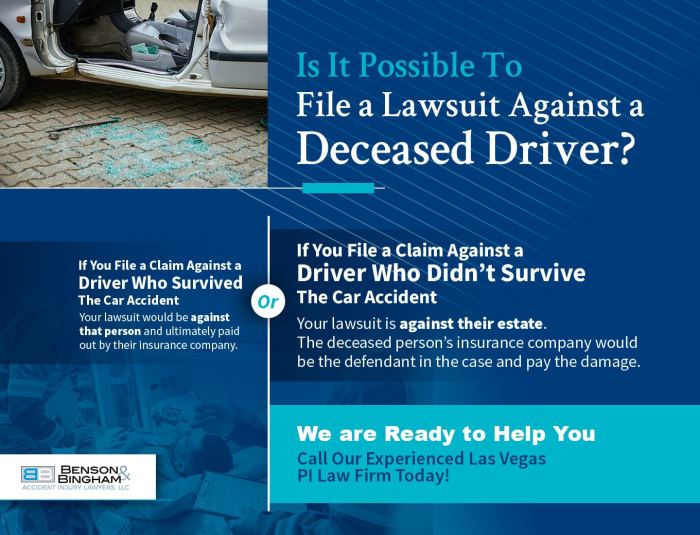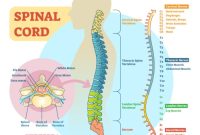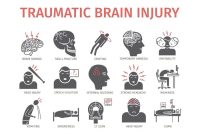Losing a loved one is never easy, and it can be even more difficult when their death is caused by the negligence of another person. If you have lost a loved one in an accident caused by a deceased driver, you may be wondering what your legal options are.
This guide will provide you with an overview of the process of filing a claim against a deceased at-fault driver, including the legal grounds for filing a claim, the process of determining fault, and the types of damages that you may be able to recover.
It is important to note that the laws governing claims against deceased drivers vary from state to state. Therefore, it is important to consult with an attorney in your state to discuss your specific case.
Overview of Filing a Claim

In the unfortunate event of an accident involving a deceased at-fault driver, it is essential to understand the legal process for filing a claim and seeking compensation for damages incurred. This guide provides an overview of the legal grounds, fault determination, and importance of preserving evidence in such cases.
Legally, the estate of the deceased driver may be held liable for the damages caused by the accident. This liability arises from the legal principle of negligence, which imposes a duty of care on all drivers to act reasonably and avoid causing harm to others.
If the deceased driver breached this duty of care by engaging in negligent or reckless behavior that led to the accident, their estate may be held responsible.
Determining Fault
Determining fault in an accident involving a deceased driver can be complex. In the absence of the driver’s testimony, investigators will rely on various factors to establish fault, including:
- Police reports and witness statements
- Physical evidence from the accident scene, such as skid marks and vehicle damage
- Medical records and autopsy reports
- Expert testimony from accident reconstructionists or other specialists
Preserving Evidence
Preserving evidence is crucial in cases involving deceased at-fault drivers. Important documents and materials that should be secured include:
- Police reports
- Witness contact information
- Photographs of the accident scene and vehicle damage
- Medical records and bills
- Insurance policy information
Identifying Responsible Parties
Identifying the responsible parties in a claim involving a deceased at-fault driver is crucial. Understanding the legal processes and parties involved will help ensure that your claim is handled efficiently and fairly.The primary responsible party is the personal representative or estate of the deceased driver.
The personal representative is the person appointed by the court to manage the deceased person’s estate. They are responsible for handling the deceased person’s assets, debts, and legal matters, including claims against the estate.Insurance companies also play a significant role in claims involving deceased drivers.
If the deceased driver had liability insurance, their insurance company will typically be responsible for covering the damages caused by the accident. The insurance company will investigate the claim and determine whether the deceased driver was at fault and, if so, the amount of damages that are owed.In
some cases, there may be multiple responsible parties in a claim involving a deceased driver. For example, if the accident was caused by a defective vehicle, the manufacturer of the vehicle may also be held liable. If another driver or vehicle owner was involved in the accident, they may also be held responsible for their own negligence.
Establishing Liability

Establishing liability in a claim against a deceased driver requires proving negligence. Negligence is the failure to exercise reasonable care, which results in injury or damage to another person or property. In the context of a car accident, negligence can be established by proving the following elements:
- The deceased driver owed a duty of care to the claimant.
- The deceased driver breached their duty of care by acting negligently.
- The deceased driver’s negligence caused the claimant’s injuries or damages.
- The claimant suffered damages as a result of the deceased driver’s negligence.
Proving Negligence
Proving negligence can be challenging, especially when the at-fault driver is deceased. However, there are several methods that can be used to establish negligence, including:
- Witness statements: Eyewitness accounts can provide valuable information about the accident, including the actions of the deceased driver and the circumstances leading up to the crash.
- Accident reports: Police reports and other accident reports can document the details of the accident, including the location, time, and any contributing factors.
- Expert testimony: Experts, such as accident reconstructionists and medical professionals, can provide technical analysis and opinions on the cause of the accident and the extent of the claimant’s injuries.
Comparative Negligence Laws
Many states have adopted comparative negligence laws, which allow the court to reduce the amount of compensation awarded to a claimant if they are found to be partially responsible for the accident. The percentage of fault attributed to the claimant will be deducted from the total amount of damages awarded.For
example, if a claimant is found to be 20% at fault for an accident, they will only be entitled to recover 80% of their damages from the deceased driver’s estate. Comparative negligence laws can significantly impact the amount of compensation awarded in a claim against a deceased driver.
Damages and Compensation
In wrongful death cases, the family of the deceased may be entitled to compensation for the damages they have suffered. These damages can include:
- Medical expenses
- Funeral expenses
- Property damage
- Loss of income
- Loss of companionship
- Pain and suffering
The amount of compensation awarded in a wrongful death case will vary depending on the severity of the injuries and financial losses, as well as the jurisdiction in which the case is filed.
Calculating Damages
There are a number of methods that can be used to calculate damages in wrongful death cases. Some of the most common methods include:
- The loss of earning capacity method
- The multiplier method
- The per diem method
The loss of earning capacity method takes into account the deceased’s age, occupation, and earning potential. The multiplier method multiplies the deceased’s annual income by a number that represents the number of years they would have been expected to live.
The per diem method awards a daily amount for each day that the deceased lived after the injury.
Factors Influencing Compensation
The amount of compensation awarded in a wrongful death case will also be influenced by a number of factors, including:
- The severity of the injuries
- The financial losses suffered by the family
- The jurisdiction in which the case is filed
- The availability of insurance coverage
It is important to note that damages in wrongful death cases are not intended to punish the at-fault driver. Rather, they are intended to compensate the family for the losses they have suffered.
Filing the Claim
To initiate a claim against the estate of a deceased at-fault driver, it’s essential to follow specific procedures and adhere to legal deadlines.
Filing a claim typically involves the following steps:
Time Limits and Deadlines
Time limits vary depending on the state where the accident occurred. It’s crucial to act promptly to preserve your rights and avoid missing any applicable deadlines.
Documentation and Evidence
Gather all relevant documentation and evidence to support your claim, including:
- Police report
- Medical records
- Insurance information
- Witness statements
- Property damage estimates
Negotiating and Settling
Negotiating with insurance companies and the personal representative of the deceased driver is crucial to reach a fair settlement. The claimant should gather evidence to support their claim and be prepared to negotiate.
Maximizing the Settlement Amount
* Present a strong case with evidence supporting the claim.
- Research comparable settlements to establish a reasonable range.
- Be willing to compromise while protecting the claimant’s interests.
- Consider hiring an attorney for guidance and representation.
Protecting the Claimant’s Interests
* Obtain legal advice before accepting a settlement offer.
- Understand the terms of the settlement, including any limitations or exclusions.
- Document all communication and agreements in writing.
Factors Influencing Negotiations
* Strength of the evidence supporting the claim
- Liability of the deceased driver
- Damages sustained by the claimant
- Willingness of the parties to compromise
- Applicable laws and insurance policies
Trial and Judgment

When liability and damages cannot be resolved through negotiations, the claim may proceed to trial. A trial is a formal proceeding where a judge or jury determines the liability of the deceased driver and the amount of damages to be awarded to the claimant.
Jury Selection
In a jury trial, a panel of jurors is selected from a pool of potential jurors. The attorneys for both parties question the potential jurors to ensure that they are impartial and have no conflicts of interest. The goal is to select a jury that is representative of the community and will fairly consider the evidence presented.
Presentation of Evidence
The trial begins with opening statements from both attorneys, who Artikel their case and the evidence they intend to present. The claimant then presents their case, followed by the defendant’s case. Evidence can include witness testimony, physical evidence, and expert testimony.
Closing Arguments
After all the evidence has been presented, both attorneys deliver closing arguments, summarizing their case and urging the jury to rule in their favor. The jury then deliberates to reach a verdict.
Factors Considered by Juries
When determining liability, juries consider factors such as the deceased driver’s negligence, the claimant’s contributory negligence, and any defenses raised by the defendant. When determining damages, juries consider the claimant’s economic losses, non-economic losses, and any mitigating factors.
Enforcement of Judgment
When a judgment is obtained against the estate of a deceased at-fault driver, enforcing it can be challenging. The estate may have limited assets, and there may be competing claims from other creditors.
One method of enforcing a judgment is to file a claim with the probate court. The probate court will administer the estate and distribute its assets according to the law. If the estate has sufficient assets, the judgment creditor may be able to collect the full amount of the judgment.
Potential Challenges
There are several potential challenges that may arise in the collection process. One challenge is that the estate may not have sufficient assets to satisfy the judgment. Another challenge is that there may be other creditors with competing claims against the estate.
In such cases, the judgment creditor may only be able to collect a portion of the judgment.
Final Summary
Filing a claim against a deceased at-fault driver can be a complex and challenging process, but it is important to remember that you are not alone. There are resources available to help you through this difficult time, and you should not hesitate to seek legal advice if you have any questions.
FAQ Section
What are the legal grounds for filing a claim against a deceased at-fault driver?
The legal grounds for filing a claim against a deceased at-fault driver are the same as the grounds for filing a claim against any other at-fault driver. These grounds include negligence, recklessness, and intentional misconduct.
How do I determine fault in an accident involving a deceased driver?
Determining fault in an accident involving a deceased driver can be difficult, but it is important to gather as much evidence as possible. This evidence may include witness statements, accident reports, and expert testimony.
What types of damages can I recover in a claim against a deceased at-fault driver?
The types of damages that you may be able to recover in a claim against a deceased at-fault driver include medical expenses, property damage, lost wages, and pain and suffering.
What is the process for filing a claim against a deceased at-fault driver?
The process for filing a claim against a deceased at-fault driver varies from state to state. However, in general, you will need to file a claim with the insurance company of the deceased driver. You will also need to provide the insurance company with evidence of the accident and your damages.
What should I do if the insurance company denies my claim?
If the insurance company denies your claim, you may be able to file a lawsuit against the estate of the deceased driver. You should consult with an attorney to discuss your options.



